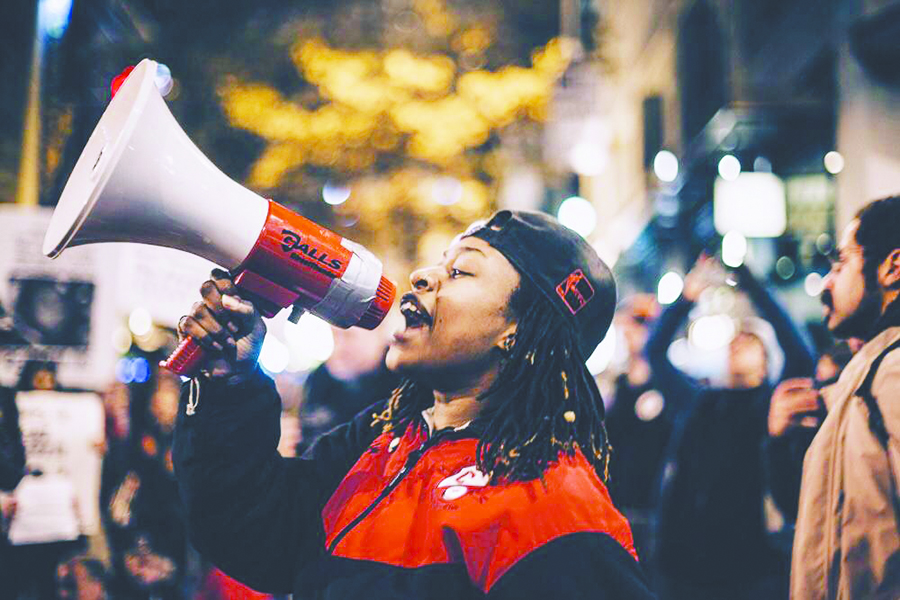At the intersection of Fairview Avenue North and Denny Way in December, Jorge Torres had gotten a little way ahead of the other protesters in a “Black Lives Matter” march when, in the corner of his eye, he saw the bike cop. “I saw [him] starting to pick up speed on his bike, with this really angry and determined look on his face. And he leaps off his bike and tackles me to the ground,” Torres says.
“I moved in quickly and contacted Torres, who immediately tried to break free from me,” says that officer, Thomas Burns, in the arrest report. Because Torres had put other protesters in danger by leading them into open traffic on city streets, Burns says in the report, “a decision was made” to arrest him.
“I spun Torres to the ground and he was laid out flat on his stomach,” Burns says. “Torres flailed about for a few seconds and immediately pulled both his arms under his body . . . I then had to use all my strength to pull out Torres’ [right] arm so we could place him in cuffs.”
Torres, who regards the arrest report as “wholesale opinion, interspersed with factoids,” describes getting dogpiled beneath several officers, with one holding his legs in a hogtie position while another ground his head into the pavement.
Charged with reckless endangerment and pedestrian interference, Torres spent a long December night in the county jail, an experience he recalls as boredom occasionally interrupted by guards’ petty bullying. After five months of hearings, which in his description mostly consisted of scheduling other hearings, the judge dismissed both of his charges “with prejudice,” meaning that they cannot be brought against him a second time.
Torres’ lawyer, Patricia Sully, describes the circumstances of his arrest as novel and alarming: “The [pre-trial] discovery supports the impression … that police were targeting and arresting those leading the march solely because they were leaders.” Scooping up protest leaders, even on charges that won’t stick, might be an effective tactic for hastening the end of a march. If so, Sully concludes, “That is a new development in the policing of protests in Seattle, and a disturbing one.”
Seattle police spokesperson Sgt. Drew Fowler doesn’t deny that police sometimes target protest leaders, but says that the main goal of Seattle police at political demonstrations is to protect lives and property. “There’s no specific effort to focus on someone who, per se, might be a leader, unless that person is going out of their way to put people into danger,” he says. If they are endangering people, he says, “that is a reasonable arrest by, I think, any standard.”
But are police using bad arrests as a tool for snatching protest leaders off the street? Fowler won’t say yes or no. “We aren’t judges,” he says. “If someone breaks the law, then we can make an arrest, and then what happens beyond that point is out of our control.”
Sully and Torres’ concern is as pertinent as ever. With May Day right around the corner and kayactivists’ showdown with a Shell oil rig expected later that month, Seattle’s long-running competition between social order and social justice shows no sign of waning.
Former mayor Mike McGinn says that competition is a good thing. “We should be glad we’ve got a city where people are using these tools of civil disobedience and protest to bring attention to things that need to be changed,” he says. This isn’t a wholesale endorsement of illegal protest tactics: When protesters began breaking windows during 2012’s May Day protests, McGinn banned weapons and weaponlike objects from all of downtown. For him, that’s what responsible governance looks like: finding a way to balance the government’s obligations to protect both First Amendment rights and property rights. “You just have to figure out how do it and to provide an environment in which people can engage in civil disobedience” without compromising public safety.
One way police can totally fail at both those goals: randomly pepper-spraying passersby. That’s what happened to Jesse Hagopian, a high-school teacher and activist, on Martin Luther King Day in an incident that McGinn calls “horrible . . . absolutely terrible.” Video of the January 20 attack quickly went viral: a thin line of bike cops is blocking protesters’ advance up Westlake Avenue when one appears to panic, screaming “Get back! Get back!” before hosing down every civilian within a 10-foot radius with pepper-spray.
A mere 20 minutes before the incident, Hagopian says, he’d been addressing marchers inside the Garfield High gym, reminding them that “there will be many people that praise Martin Luther King in word, but then turn around and disparage direct action and civil disobedience” whenever it rears its head in the present.
“That is a vulgarity to the legacy of a man who was arrested I don’t know how many times in the struggle for civil rights,” Hagopian says.
King’s struggles took place primarily in the South, but Seattle’s got its own history of civil disobedience. When shipbuilders’ bosses refused to raise pay and lower hours, Seattle’s economy screeched to a halt as 60,000 workers walked off the job in the General Strike of 1919. Nineteen years later, after watching a coalition of radical leftists come this close to seizing the governorship through a procedural maneuver, the U.S. Postmaster quipped, “There are 47 states and the Soviet of Washington.” And ever since the infamous 1999 World Trade Organization protests, the Emerald City has kept its reputation as the town where activists throw down.
In many of these protests, Seattle police have found themselves on the wrong side of public perception after the crowds disperse. Torres’ and Hagopian’s experiences suggest that that tradition, too, isn’t going away anytime soon.
cjaywork@seattleweekly.com








